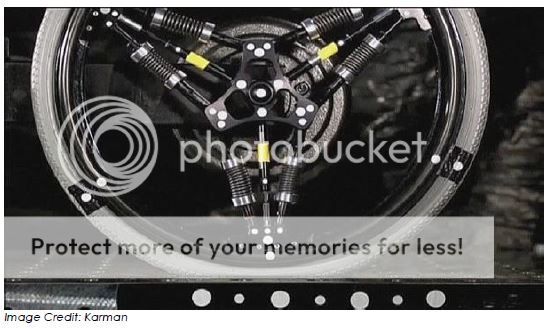Moving towards the electrification of suspension systems for EV and HEV
Add bookmarkElectrified regenerative suspension systems for EV and HEV
According to research conducted by Navigant Research the global passenger vehicle market will show a compound annual growth rate (CAGR) of 2.4% between 2013 and 2020: In comparison HEVs will show a CAGR of 11.5%, PHEVs 31.9% and BEV’s will grow at 31.5% in the same period. Despite this positive forecast, EV’s face several challenges in gaining widespread acceptance; none greater than range anxiety, regardless of whether or not it’s real or perceived. Currently no EV has a range over 500 km, significantly less than that of conventional vehicles. However, Tesla Motors’ CEO, Elon Musk, recently announced that Tesla would address this by increasing the range of the Model S to 1000km by 2017.

Regenerative suspension systems increase EV’s range
However, for EVs to achieve an acceptable range, several energy conservation strategies have to be applied. While regenerative braking is well established, the relatively new regenerative active suspension systems have the potential to bring about further energy conservation and range extension improvements.
As far back as 2011 a team led by professor Lei Zuo, Ph.D., from the Advanced Energy Technology & Research Center at Stony Brook University, produced an award winning regenerative suspension system that could recover 100-400 watts of vibration (kinetic) energy from a passenger car travelling at 100Km/h.
[eventpdf]
While this was achieved by pairing an electricity generator to a conventional suspension system with steel springs and hydraulic shock absorbers, Intertronic Gresser GmbH in Wýrzburg, Germany have recently applied to patent a unique "electricity-generating suspension system for hybrid and electric cars". The company claims to increase the range by 50% in relation to the battery storage capacity!
In order to achieve this, the regenerative system converts a greater percentage of the kinetic energy from the vertical suspension movement, as well as that harvested from the body acceleration, into electricity by using coupled linear generators.
As there are no steel springs and shock absorbers, the suspension function is provided by an electronically controlled, double-action hydraulic cylinder. Vibration-damping is performed by an electronically controlled mechanically coupled linear generator which also generates electricity by utilizing opposing induction forces (Lorentz force).
Assuming an average wheel suspension movement, per meter travelled, of +/- 25 mm, the potential energy yield from the regenerative suspension would be 15 kWh over a distance of 100 km.
Furthermore, in addition to harvesting the wheel suspension energy, the kinetic energy generated through the vehicle’s vertical body movement is also converted into electricity. Considering the "sprung" mass of the average vehicle, this energy can be significant: In a vehicle with a sprung mass of 2 t and an assumed average movement of only 5 mm/m, approximately 2.8 kWh per 100Km can be generated.
Although the Intertronic Gresser system generates more electrical energy as the sprung mass increases it’s common practice to reduce electric-vehicle mass to improve range. Unfortunately this negatively impacts the subjective Noise Vibration and Harshness, drivers and occupants experience.
EVs face unique NVH challenges
The lack of broadband NVH produced by the conventional ICE as well as the reduction in vehicle weight and cabin noise levels have significantly moved the goal posts in damping out noise and vibration in EVs.
Moreover, the reduction in mass also affects the transmission of NVH generated by the road surface and transferred to the cabin via the suspension system.
In a novel development Israeli startup SoftWheel, which already has the wheelchair and bicycle world talking about its groundbreaking suspension system, is now contemplating the electric vehicle market. Daniel Barel, CEO of Softwheel, recently disclosed that several car manufacturers have already approached the Tel Aviv-based company about its technology that can harvest energy and absorb shocks, producing a smoother ride. The wheel which incorporates a selective suspension mechanism only acts when an impact above a preset threshold is encountered. This threshold is determined according to user requirements and is easily adjustable.

Under normal conditions on smooth surfaces, the suspension mechanism remains static resulting in a rigid wheel. However, when encountering an impact caused by an obstacle above a specific threshold, the wheel’s Selective Suspension mechanism comes into play: This causes a shift of the wheel’s hub from its central position which produces a cushioning effect that dramatically reduces the NVH transferred to the vehicle’s occupants.
Once the obstacle has been traversed the wheel regains its rigidity and responsiveness as the hub smoothly moves back to its central location. SoftWheel’s technology ups the ante on current tyre and suspension systems with its wheels automatically responding to changes in the road (or offroad) surface.
The company is currently focused on improving wheelchair and bicycle wheels but hopes to crack the automotive market in the near future. According to Barel the company has been invited to incorporate the technology into hub motors of an e-racing car. The Israeli Alternative Fuels Initiative of the Prime Minister’s Office believes this will showcase the technology to the automotive market.
With manufacturers such as Honda, Ford and Tesla exploring the advantages of AWD in EVs, the use of in-wheel motors pose unique challenges for NVH engineers. In vehicle dynamics, an increase in unsprung mass while reducing the sprung mass of a vehicle has a negative effect on NVH as well as handling.
Furthermore, in an EV the NVH produced by the electric motor on each wheel introduces an additional noise and vibration source: The torque vibration from the electric motor transmitted to the bodyframe through the suspension system is difficult to dampen without adding more unwanted mass.
The NVH of the system is further challenged by the use of switched reluctance motors. These are well suited to in-wheel-motor-driven electric vehicles because of their high torque density, operating efficiency and excellent power–speed characteristics.
However, the inherent high torque ripple and unbalanced radial force vibrations are very difficult to dampen. Several studies indicate that the vertical force of the switched reluctance motor also has a great effect on the lateral and anti-rollover stabilities of the vehicle. This is a result of the vertical force of the switched reluctance motor being directly applied to the wheels, resulting in significant variations in the tyre load.
Moreover, the frequency of the vertical force of the switched reluctance motor covers a wide bandwidth which includes the resonant frequencies of the vehicle body’s vibrations and the wheel movement. As a result, the comfort of the occupants is considerably reduced.
While vibration transmission through the suspension system may be seen as a constant improvement of existing technologies, quietening tyre generated noise may be more challenging. Cavernous resonance, in particular, is proving difficult to control. Generated by the resonance of the air in the tyre this noise input is particularly intrusive in the quiet environment of the cabin (As well as in drive by conditions).
One way of reducing this noise is by using a disc wheel with a hollow rim containing communicating passages which, in effect, produces a Helmholtz resonator. This technology not only reduces noise but also unsprung mass.
After over 100 years of continuous development of the motor vehicle, the proliferation of EV’s is challenging automotive engineers’ creativity in coming up with new solutions to challenges never before encountered. When viewed as part of the greater picture, energy conservation and NVH may seem trivial but in actual fact may determine the acceptance of the technology by the consumer.






















